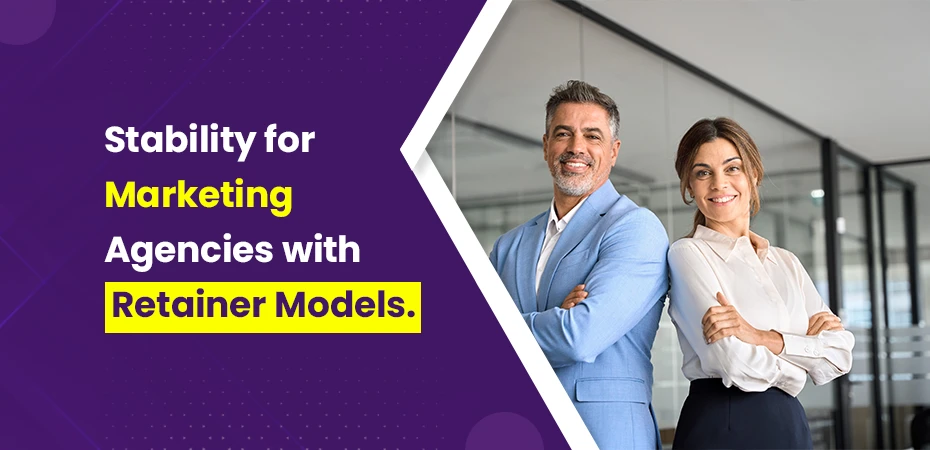Stability for Marketing Agencies with Retainer Models



Are you tired of the ups and downs in your agency’s income? A simple solution is retainer models.
Retainer models act as a financial safety net for your agency. Instead of finding new projects each month, you create long-term partnerships where clients pay a set fee for regular services. This turns your agency from a project-based business into a steady, growing one.operation.
Here’s what makes retainer models powerful:
- Predictable Revenue: Say goodbye to feast-or-famine cycles
- Stronger Client Relationships: Build lasting partnerships that grow over time
- Enhanced Service Quality: Focus on delivering value rather than constant pitching
In this guide, you’ll discover:
- Different types of retainer models and their applications
- Proven strategies for pricing your retainer services
- Tips for managing client expectations
- Tools to streamline your retainer-based operations
Ready to unlock sustainable growth for your marketing agency? Let’s dive into the world of retainer models and transform your business into a stability powerhouse.
Agency Retainers- Meaning and Benefits
Agency retainer models represent a structured pricing approach where clients pay a predetermined fee for ongoing marketing services. Unlike traditional project-based pricing, retainers establish a consistent revenue stream through regular payments – typically monthly or quarterly.
Let’s explore the three main types of agency retainers with their pros and cons:
1. Project-Based Retainers
This type of retainer in business is ideal for agencies that work on specific marketing campaigns or projects with clear deliverables and defined timelines.
- Pros: Clear deliverables, defined timelines
- Cons: Limited flexibility, potential scope creep
2. Performance-Based Retainers
Performance-based retainers are suitable for agencies that focus on delivering results and aligning with client goals.
- Pros: Results-driven, aligned with client goals
- Cons: Revenue fluctuations, higher risk
3. Full-Service Retainers
Full-service retainers are for agencies that offer a wide range of marketing services and want to build stronger, long-term relationships with their clients.
- Pros: Comprehensive coverage, deeper client relationships
- Cons: Complex management, resource-intensive
Each retainer system serves different business needs. Project-based retainers work well for specific campaigns, while performance-based models suit results-focused clients. Full-service retainers create integrated marketing solutions across multiple channels.
A successful retainer model depends on matching your agency’s capabilities with client expectations. The right structure builds predictable income streams while delivering value to your clients.
Benefits of Retainer Models for Marketing Agencies
Retainer models offer many benefits for marketing agencies that want to grow and build stable businesses. Let’s look at the key reasons why retainer agreements are great for agency growth.
Predictable Revenue Streams
A steady flow of income transforms agency operations:
- Accurate Financial Forecasting: Monthly recurring revenue enables precise budget planning
- Investment Confidence: Stable cash flow supports strategic hiring and resource allocation
- Reduced Sales Pressure: Less time spent chasing new projects means more focus on delivery
Enhanced Client Value Delivery
Retainer relationships create space for deeper strategic work:
- In-depth understanding of client business objectives
- Proactive problem-solving rather than reactive fixes
- Consistent brand voice and messaging across campaigns
- Data-driven optimization through long-term performance tracking
Streamlined Operations
Regular client engagements lead to:
- Efficient Resource Planning: Teams can be structured around consistent workloads
- Improved Project Management: Standardized processes for recurring deliverables
- Better Work-Life Balance: Reduced overtime and crisis management
- Higher Quality Output: Teams develop expertise in client industries
Strategic Partnership Development
Retainer models foster deeper client relationships through:
- Regular strategy sessions and performance reviews
- Shared goals and metrics for success
- Collaborative problem-solving approaches
- Built-in opportunities for professional service expansion
Team Growth and Development
Stable client relationships support:
- Specialized Skill Development: Team members become industry experts
- Career Path Planning: Clear progression opportunities
- Knowledge Retention: Reduced turnover due to job satisfaction
- Innovation Opportunities: Space to experiment with new approaches
These benefits create a positive loop—happy clients stay longer, bringing in steady income and allowing for better service. This cycle helps the agency grow while keeping quality high and the team satisfied.
The benefits are more than just financial. They help the agency grow steadily and become a leader in the market. As trust builds between the agency and client, new opportunities for extra services come up, helping the agency grow and earn more.
Improved Efficiency and Resource Management
Retainer agreements transform how marketing agencies manage their resources and streamline operations. With predictable monthly income, agencies can:
- Strategic Staff Planning: Hire and maintain the right talent mix based on consistent client needs
- Resource Optimization: Allocate team members efficiently across accounts without overextending
- Technology Investment: Make informed decisions about software and tool subscriptions
With steady income from retainers, agencies can hire skilled staff and use better tools. They don’t have to worry about money, unlike with project-based work. This stability creates a cycle where having better resources leads to better results for clients.
Agencies operating on retainer models report:
- 40% reduction in administrative tasks
- Improved project completion rates
- Higher team utilization rates
- Reduced overtime costs
- Better work-life balance for staff
A structured retainer model helps agencies create clear processes and workflows. Teams can focus on delivering results instead of always adjusting to different client needs. This consistency leads to:
- Faster project turnaround times
- Reduced errors and revisions
- More accurate time tracking
- Better resource forecasting
- Enhanced quality control measures
Retainer work helps agencies keep the right balance of staff and clients. This prevents too few or too many clients for the team, avoiding burnout. As a result, the agency delivers better quality work and keeps clients happy.
Pricing Strategies for Retainers
Developing an effective pricing strategy for retainer services requires a balance between value delivery and profitability. Here are key pricing models marketing agencies can implement:
1. Fixed-Fee Monthly Retainers
- Set monthly fee for predetermined deliverables
- Predictable revenue stream for agencies
- Clear budget allocation for clients
- Ideal for ongoing marketing activities
2. Tiered Retainer Packages
- Bronze, Silver, Gold structure
- Different service levels and price points
- Allows clients to scale services as needed
- Creates natural upsell opportunities
3. Value-Based Pricing
- Pricing tied to client’s ROI
- Focus on results rather than time
- Higher profit margins for exceptional performance
- Requires robust tracking and reporting
4. Hybrid Models
- Base retainer + performance bonuses
- Core services plus flexible add-ons
- Combines stability with scalability
- Accommodates varying client needs
5. Pay-As-You-Go Credits
- Pre-purchased hours or service credits
- Flexible usage within defined period
- Minimum monthly commitment
- Suits clients with fluctuating needs
Choose a pricing model that fits your agency’s services and what your market expects. Think about things like how complex the services are, what resources you need, and where you stand in the market. It’s important to regularly review and adjust your pricing to stay profitable and competitive.
Challenges in Transitioning to a Retainer Model
Making the shift from project-based work to a retainer model brings unique challenges for marketing agencies. Let’s explore these hurdles and understand how to navigate them effectively.
1. Managing Client Expectations
Managing client expectations is crucial during the transition to a retainer model. Here are some strategies to effectively manage their expectations:
- Setting realistic deliverables and timelines
- Establishing clear communication channels
- Defining emergency response protocols
- Creating transparent reporting systems
2. Scope Creep Management
Scope creep refers to the gradual expansion of project boundaries beyond what was initially agreed upon. It can be detrimental to both agencies and clients if not managed properly. Here are some ways to manage scope creep effectively:
- Documenting specific service boundaries
- Implementing change request procedures
- Creating clear escalation paths
- Setting up buffer zones for unexpected tasks
The transition period requires careful planning and strategic client education. Many clients might resist the change, particularly those accustomed to paying per project.
3. Common Implementation Challenges:
During the implementation of the retainer model, agencies may face several challenges:
- Resistance from existing clients
- Internal team adaptation
- Resource allocation adjustments
- Service standardization
- Performance measurement metrics
Successful agencies tackle these challenges by creating detailed onboarding processes and service level agreements. They invest a good amount of time in training their teams to handle retainer-based relationships and develop systems to track deliverables effectively.
4. Risk Mitigation Strategies:
To mitigate risks associated with the transition, agencies can employ various marketing strategies:
- Pilot programs with select clients
- Phased implementation approach
- Regular feedback collection
- Flexible adjustment periods
- Performance guarantee options
A clear transition plan helps agencies keep service quality while switching to the new model. This plan should include backup strategies for different situations and clear steps for handling client concerns during the change.
Tools and Resources for Managing Retainers
Effective retainer management requires robust tools to track deliverables, monitor performance, and maintain client relationships. Here’s a curated list of essential tools for marketing agencies:
Project Management and Client Communication
- ClickUp: A versatile platform offering customizable workflows, time tracking, and client collaboration features
- Asana: Helps organize tasks, set deadlines, and maintain transparent communication
- Monday.com: Provides visual project tracking and resource allocation capabilities
Performance Tracking and Reporting
- AgencyAnalytics: Creates automated client reports and dashboards for marketing metrics
- Google Data Studio: Builds customizable reports combining data from multiple sources
- Databox: Offers real-time performance monitoring and goal tracking
Time and Resource Management
- Harvest: Tracks billable hours of work (hourly rate) and manages team capacity
- Toggle: Monitors time spent on client projects and generates detailed reports
- Resource Guru: Helps optimize team scheduling and workload distribution
Client Relationship Management
- HubSpot CRM: Manages client interactions and tracks engagement
- Copper: Integrates with Google Workspace for seamless client communication
- Pipedrive: Streamlines client onboarding and relationship management
These tools can be mixed and matched based on your agency’s specific needs. The right combination will help streamline operations, improve client satisfaction, and maximize the value delivered through retainer agreements.
Conclusion
Retainer models are a game-changer for marketing agencies looking to grow sustainably and operate efficiently. By moving away from project-based work and adopting retainer contract work, agencies can enjoy steady income, better client relationships, and improved service delivery.
Your agency’s success depends on picking the right retainer model that fits your skills and meets your clients’ needs. Whether it’s performance-based, project-based, or full-service, each type has benefits that can help your agency grow and stay stable.
To make retainer models work, you need good planning, clear communication, and strong systems. The rewards aren’t just about steady income – they also bring chances for growth, new and good ideas, and better partnerships. Our team of experts at Phoenix Ninja will help you throughout the process.
Achieve stability and consistent growth for your agency with a digital marketing retainer model.
Frequently Asked Questions (FAQs)
Most successful business retainer agreements last 6-12 months, giving enough time to show value and get good results.
Yes! Customization helps meet specific client needs while maintaining profitability. Create tiered options with varying service levels.
Set clear limits in your agreement, write down extra requests, and keep communication open about what is included in the retainer.
Include clear termination clauses in your agreement, typically requiring 30-60 days’ notice. Consider implementing cancellation fees for early termination.
Review pricing annually or when significant changes occur in service delivery costs. Regular reviews ensure sustainable profitability.